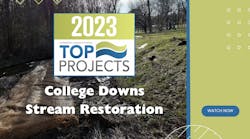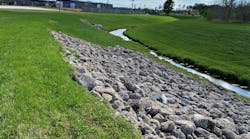Higgs often uses different types of silt fence in his work. He obtains it from GETSco, which manufactures a full line of DOT and non-DOT silt fence with custom printing. The company also carries SiltShield.
“It’s an ‘everything at once’ type of situation,” Higgs says of his work. “It’s very seasonal. It’s a very weather-driven type of thing, so we try to be proactive and do prep work in case we have a big rainstorm or snow event, so it’s easier for us to handle during the event.”
Higgs faces an unusual challenge these days. “There are quite a few developments out there right now that are in the middle of foreclosure and bankruptcy proceedings. The developer has a bond, and the property is going through foreclosure through the bank and in most cases it is not even going to get auctioned.
“Now you have a bank sitting there with a bond responsibility. You’ve got a county that doesn’t really care who has it—they just want it taken care of. A lot of times the developers are more knowledgeable than the bank; they are more hands-on.”
Various consultants work with the banks on property issues, and Higgs works with them on some of the bank-owned properties to handle erosion and sediment control situations.
“It gets a little more hairy, because you’ve got homeowners’ associations that are started and homeowners that are in there,” Higgs says. “You might have a 50-lot subdivision with 10 or 12 homeowners in there. You might have some lots that are being sold to investors, so we’ve been trying to jump at the opportunity that is in some of this turmoil right now.”
Environmental concerns underscore the importance of the work. “We’re right by the Chesapeake Bay and the Atlantic Ocean,” says Higgs. “Obviously, we are concerned about the Chesapeake Bay. The Chesapeake Bay watershed ecosystem is a target for federal dollars for critical areas and wetland protection.
“We definitely have a lot that we need to deal with in the matter of stormwater management,” Higgs adds. “We’re a very agricultural area, and there’s a lot of money put into the agricultural community for good water management practices. What’s required of many of these developments is that they have to be maintained.”
Silt fence will always have a place in sediment and erosion control, Higgs says.
“In my opinion, silt fence is the ‘old horse.’ It does work, and it works a lot. There’s a lot of new technology out there these days that is more efficient and has been proven better or as good, but I think silt fence will always have its place.
“The new technologies and new ways of doing things take the place of some of that silt fence. In a development where there is usually 20,000 feet of silt fence, there might still be 5,000 feet, but I think you’re going to see massive areas done in different ways.”
Those ways will decrease and eliminate some of the sedimentation and runoff in an environmentally friendly way, he adds.
“Silt fence has a maintenance component to it,” Higgs acknowledges. “Some of these projects are long-term projects. You can put up 20,000 feet of silt fence, and the project can take 10 years to build out. We can get in some grass buffers and some things like that that are going to require less maintenance. Silt fence is like putting a tourniquet on a bleeding arm. It will stop the bleeding, but if you take it off, it’s going to bleed again.”
On this Melbourne, FL, project, a crew of three installed 8,000 feet of fence in less than 24 hours with a tommy Silt Fence Machine.
What one uses to install a sediment control product is just as critical as the product itself for a project’s success.
Adam Mallard installs silt fence and turbidity barriers for Our Land Environmental in Cocoa, FL, a three-person company that includes his wife Balinda and Brian Amerson. It’s a side business for Mallard, whose day job is working for an underground utility contractor.
Our Land Environmental uses the tommy Silt Fence Machine in its work. Mallard saw it as a way to cut labor and machine rental costs so the company could pursue larger jobs and retain more of its revenues for growth.
“I looked at the silt fence when we started the business, but it wasn’t feasible,” Mallard says. “But then we saw a few jobs coming down the pipe that had very long distances—one of them was 8,000 linear feet and one of them was 14,000 linear feet of silt fence—so we saw the opportunity to use the tommy and bought it.”
Although the larger job fell through, Our Land Environmental was able to pay for the machine through the other job, a highway resurfacing project on Apollo Boulevard in Melbourne.
There was a time benefit as well: The job took three people less than 24 working hours. “In my opinion, the fence is a lot more stable than the standard DOT requirement,” Mallard says, noting that the Florida’s transportation department’s standard for silt fence is a minimum of 60 grain fence fabric with stake spacing every 6 feet.
“I have nothing but good to say about it,” he says of the tommy. “We don’t have to worry about extra labor costs. It‘s very effective.”
Most of the jobs in which Our Land Environmental is involved include site perimeters and jobs that have yet to be cleared. “The contractor will clear a path, and we put our fence down in the middle of the woods,” says Mallard.






